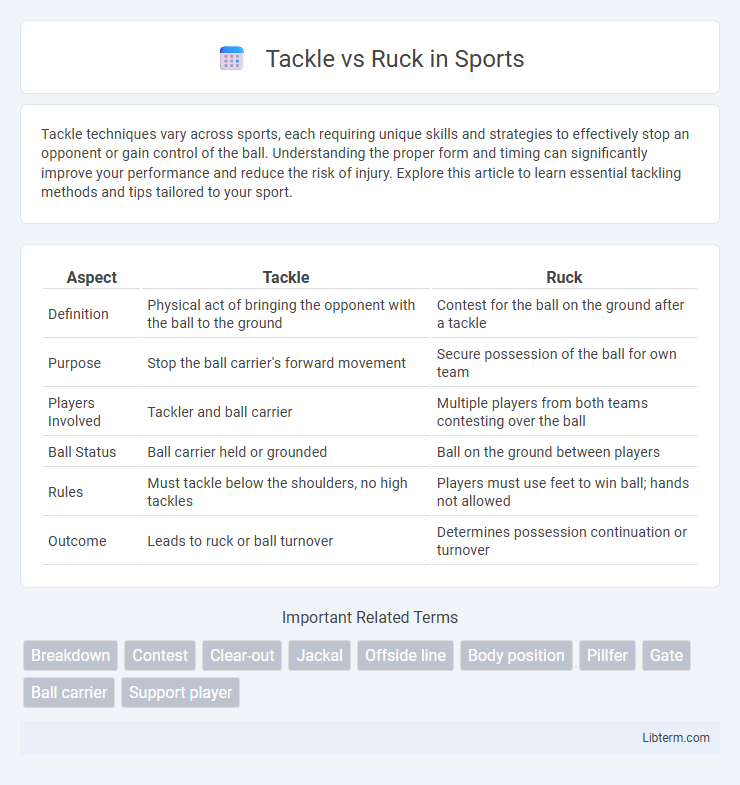Tackle techniques vary across sports, each requiring unique skills and strategies to effectively stop an opponent or gain control of the ball. Understanding the proper form and timing can significantly improve your performance and reduce the risk of injury. Explore this article to learn essential tackling methods and tips tailored to your sport.
Table of Comparison
| Aspect | Tackle | Ruck |
|---|---|---|
| Definition | Physical act of bringing the opponent with the ball to the ground | Contest for the ball on the ground after a tackle |
| Purpose | Stop the ball carrier's forward movement | Secure possession of the ball for own team |
| Players Involved | Tackler and ball carrier | Multiple players from both teams contesting over the ball |
| Ball Status | Ball carrier held or grounded | Ball on the ground between players |
| Rules | Must tackle below the shoulders, no high tackles | Players must use feet to win ball; hands not allowed |
| Outcome | Leads to ruck or ball turnover | Determines possession continuation or turnover |
Understanding the Basics: What is a Tackle?
A tackle in rugby involves a player bringing an opponent carrying the ball to the ground to stop their progress and regain possession. It requires proper technique to ensure the tackled player releases the ball immediately, allowing teammates to contest possession. Understanding tackle rules is essential to avoid penalties and maintain game flow.
What Defines a Ruck in Rugby?
A ruck in rugby is defined by the presence of one or more players from each team, on their feet, in close proximity over the ball on the ground after a tackle has been made. Players must use their feet to contest possession without hands, while remaining bound and mobile around the ball. This phase strictly prohibits handling the ball, and it serves as a critical mechanism to maintain continuity and contest possession during open play.
Key Differences Between Tackle and Ruck
A tackle occurs when a player holding the ball is brought to the ground, immediately stopping play and initiating a contest for possession. A ruck forms after the tackle, involving players from both teams binding over the ball on the ground to compete for control without handling the ball. The key difference lies in the tackle's role as a method of stopping play versus the ruck's function as a dynamic contest for ball possession following the tackle.
Legal Requirements: Tackle vs Ruck Rules
In rugby, the legal requirements for a tackle dictate that the ball carrier must be brought to ground and the tackler must release the player and the ball immediately after contact. During a ruck, players must enter from behind the hindmost foot of the last teammate in the ruck, binding onto teammates to contest possession, with hands prohibited on the ball until it emerges. Violations of these rules result in penalties, ensuring fair competition and player safety during these critical phases.
Player Roles in Tackle and Ruck Situations
In tackle situations, the primary role of the tackler is to stop the ball carrier's forward progress and bring them to the ground, while supporting defenders secure the tackle area to prevent offloads. Ball carriers aim to protect possession and set up quick ball recycle by placing the ball strategically at their side. In ruck scenarios, players known as "ruckers" must clear out opponents to secure the ball, with scrum-halves positioned to quickly retrieve and distribute it, ensuring continuity in play and maintaining offensive momentum.
Common Mistakes in Tackles and Rucks
Common mistakes in tackles include improper body positioning, such as leading with the head or failing to wrap the arms around the opponent, which increases the risk of injury and reduces tackle effectiveness. In rucks, players often commit errors by not clearing out opponents correctly, standing off their feet, or failing to maintain a low body position, leading to penalties or loss of possession. Mastering technique in both tackles and rucks is crucial for maintaining team control and ensuring player safety during the game.
Safety Measures: Minimizing Injury Risks
In rugby, understanding the safety measures between tackles and rucks is crucial for minimizing injury risks. Proper tackling techniques involve using the shoulder to make contact below the opponent's chest, keeping the head to the side to avoid concussions, whereas ruck safety emphasizes clearing players cleanly and avoiding dangerous play such as stamping or collapsing the ruck. Both actions require adherence to World Rugby's safety protocols, including training on body positioning, maintaining control, and enforcing penalties for foul play to protect players from common injuries like concussions, sprains, and fractures.
Impact on Game Strategy: Tackle and Ruck
Tackles and rucks play pivotal roles in rugby's game strategy by dictating possession and territorial advantage. Effective tackling disrupts the opposing team's attack, forcing turnovers and creating opportunities for counter-attacks. Dominating the ruck secures ball retention, enabling structured offensive phases and controlling the game's tempo.
Training Drills for Improving Tackle and Ruck Skills
Training drills for improving tackle and ruck skills in rugby emphasize technique, timing, and physicality. Tackle drills focus on safe body positioning, impact control, and effective grip through repeated one-on-one exercises and resistance training with tackle bags or pads. Ruck drills prioritize quick ball retrieval, body leverage, and positioning under pressure using simulated breakdown scenarios and competitive maul formations to enhance decision-making and endurance.
Recent Changes in Tackle and Ruck Laws
Recent changes in rugby tackle laws emphasize player safety by limiting high contact and mandating clear tackle completion signals, affecting tackle technique and referee decisions. Ruck law updates focus on quicker ball release and stricter enforcement of offside lines to accelerate gameplay while reducing dangerous infringements. These modifications enhance game flow and protect players, reflecting evolving standards in professional rugby regulations.
Tackle Infographic

 libterm.com
libterm.com